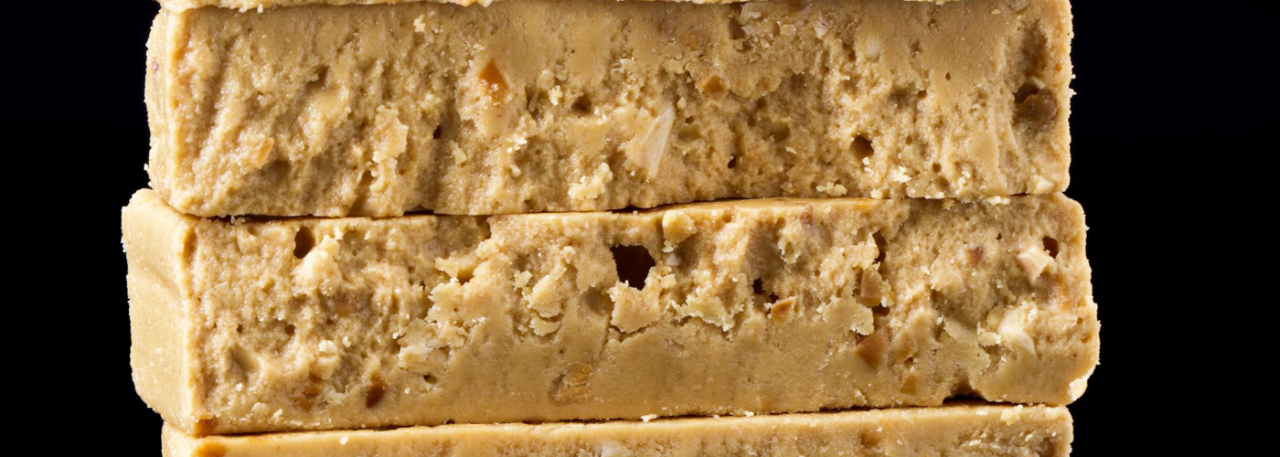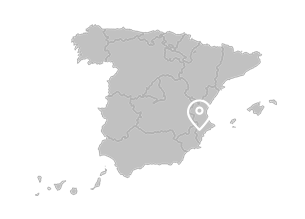.png.transform/rendition-xs/image_image%20(1).png)
Jijona PGI
Turrón de Jijona, a soft confectionery made by cooking sugar and honey, adding and kneading in roasted almonds and egg white.
Tasting notes
Sweet, with a slight retronasal touch of herbs such as rosemary and thyme coming from the honey, and a slightly smoky, warm taste of noble wood, from the roasting of the almonds. On the nose, the rounded aroma is reminiscent of spice and herbs, such as ginger and cardamom. The viscosity and superficial oiliness of the mixture give a slightly breakable texture. The shape, size and direction of the particles are irregular throughout. When chewed, the mixture is smooth and velvety, reminiscent of peach skin. This is the result of the gumminess and adhesiveness of the mixture on the tongue and the palate. The residual sensation is one of fast breaking up of the mixture and absorption of its components.
Other notes
The prestige and reputation of the Turron made in Jijona are endorsed by their quality, which is guaranteed by the achievement of three specific characteristics of its production:
- Natural ingredients (almonds, honey, sugar and egg white) of the most select varieties on the market.
- The application during the elaboration of the turron of traditional techniques (toasting - ball point cooking - emulsifying, etc.) and indigenous utensils (toasters, mechanics, stone mills, refiners, boixets, etc.) that give them authenticity and differentiation.
- The know-how and good work of the artisan hands of the “Turron Expert Master” at the time of the adaptation and final finishing of the product.
All the turron covered by the Geographical Indications are made in the maximum commercial categories allowed by national regulations, which are detailed in the product labeling as SUPREME QUALITY and EXTRA QUALITY, under the following composition and analytical properties requirements:


Production / Processing method
The almonds must come from Regions of Mediterranean climate around the world. In Spain, we can find them in the Valencian Community and its surroundings (north of the Region of Murcia, the Balearic Islands, province of Albacete, etc.), Aragon, Catalonia and Andalusia. They must be clean and healthy and belong to the Comuna (Valencia), Mallorca, Marcona, Mollar and Planeta varieties.
The honey must be pure bees’ rosemary, orange blossom or thousand-flower honey with a minimum of 10% coming from the same areas as the almonds. Rosemary honey is used for its flavor and whiteness on cooking, and orange-blossom honey for the freshness and aroma it gives the end product. Physical, chemical and organoleptic analyses are carried out to ensure the best honey is selected and purchased for making turrón. Normally, granulated sugar is used, preferably as white as possible. Fresh eggs are used to provide semi-liquid yolks and dried whites.
The production process starts with the roasting of the peeled almonds in rotating cylinders over intense heat. A mixture containing the right proportions of sugar and honey is cooked in a turning beater holding up to 50 or 60 kg (110-132 lb), then diluted egg white is added to whiten it. As the moisture evaporates, the right consistency is gradually achieved. The mixture of sugar and honey is called molasses and the amount of cooking needed to reach the soft ball point is one of the best-kept secrets of the turrón producers. After checking the temperature, the beating time and the degree of cooking, the chef takes a sample of the mixture and stretches it to form a thread which he then rolls up and tastes to check that the caramelization is just right. This is when the almonds are added, mixing them in with paddles in synchronized movements and turning over the mixture until they are evenly distributed.
While still hot, the resulting mixture is spread out manually in sheets 1 cm / 0.3 in thick on cooling tables. Once it is cold, the sheets are ground in mills made of granite or other stone. The resulting powder is refined in steel cylinders until the desired, almost fluid texture is obtained.
This is then transferred to a purpose-built tub holding 50 to 60 kg / 110 lb-132 lb called a boixet. About 2 kg( 4,40 lb) of roasted almonds are added and the mixture is then cooked again at a medium temperature. During the cooking it is rhythmically beaten by a mechanical beater inside the tub. After 2½ hours, the almond oil is gradually released and binds with the sugars. The point at which the right degree of compactness and cooking are achieved is called inversion. If the turrón is to be grainy, a second batch of broken, roasted almonds is added and mixed in while the mixture is still hot.
The product is then poured into cases containing about 6 kg / 13.2 lb and left to stand for 24 hours, without covering it with wafers as with other types of turrón. When cold, it is cut into bars and packed. It is presented in rectangular portions weighing from 15 to 90 g / 0.53 – 3.17 oz or from 100 to 700 g / 3.53-24.6 oz.
Geography / Relief and climate
Among the turron and other traditional Christmas specialties made in Jijona, the varieties stand out for their popularity and tradition: Jijona Turron and Alicante Turron. These varieties, registered in the European Union as Protected Geographical Indications, protect the production of both turron in the municipality of Jijona, with an area of 16,129 hectares, endorsing an invaluable centennial culture, over 500 years old, in the production of these products. , which is why this city has managed to establish itself as JIJONA, The Cradle of Turron.These Protected Geographical Indications cover the production of both turron varities by a total of 24 manufacturing-packaging companies located in the municipality, with an average production of 5 million kilos, of which export accounts for around 11% of production, the rest is sold in Spain. In turn, 55% of the IGP protected turron is marketed as Alicante Turron and 45% as Jijona Turron.These varieties of turron have been endorsed as typical foods of a Mediterranean lifestyle, both for their nutritional, functional and healthy properties, endowed to the product by the natural ingredients that compose it, and for the care, dedication and know-how with which the turron masters makers put during the elaboration of the same ones, making that year after year, generation after generation, these products arrive and enchant all the most exquisite palates from Jijona (Xixona) – Alicante – Valencian Community - Spain.
Regulatory Council
Consejo Regulador de las II.GG.PP. Jijona y Turrón de Alicante
C/ Foia de Martin, s/n - Plgo. Industrial El Espartal III
03100 Jijona (Alicante)
Tel: (+34) 965 612 446
consejoregulador@jijona.com
www.jijona.com
Sources:
- Spanish Ministry of Agriculture
The viscosity and superficial oiliness of the mixture give a slightly breakable texture.


- Jijona 1
- Jijona 2

Jijona (Valencian Community)
